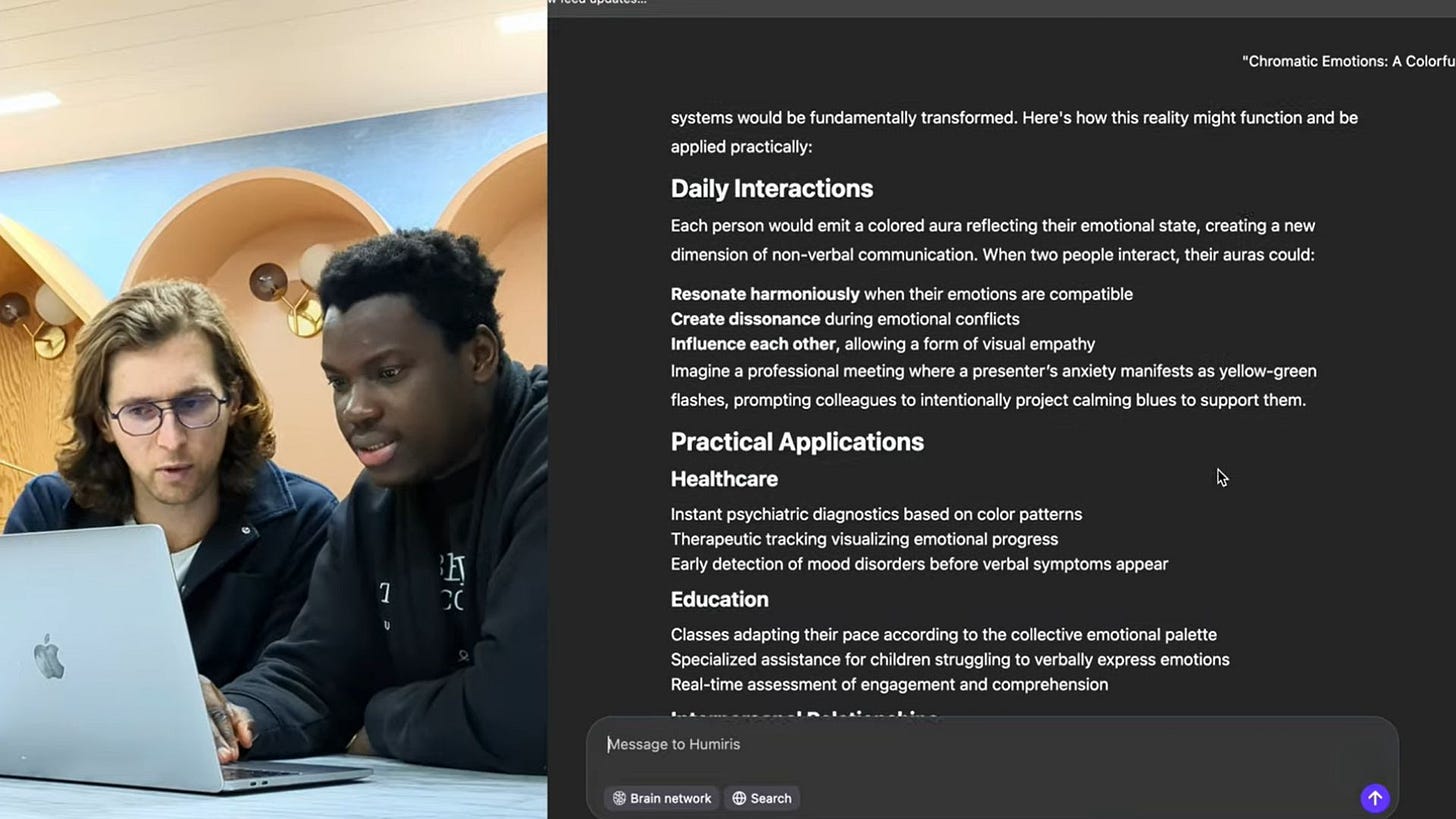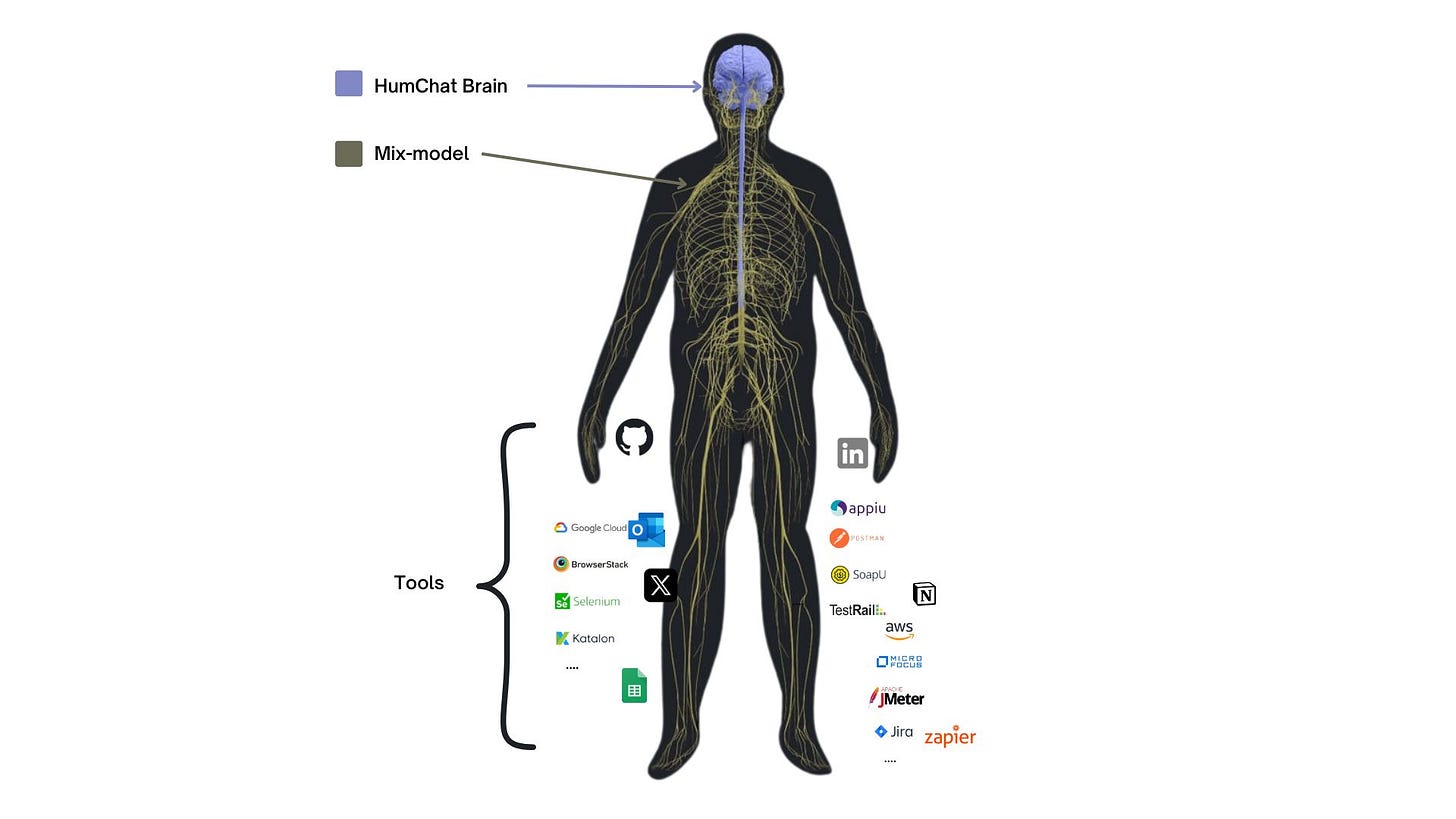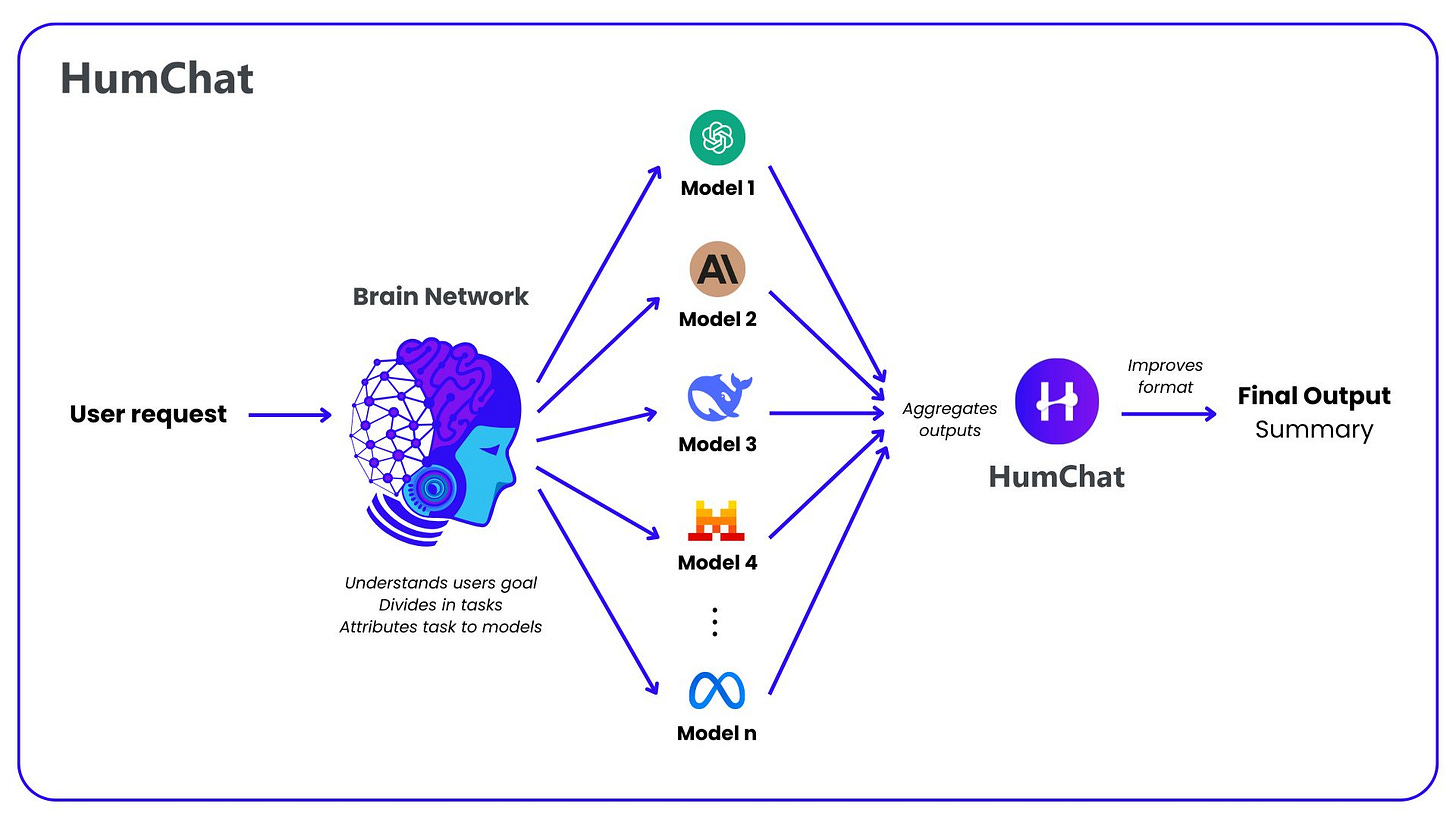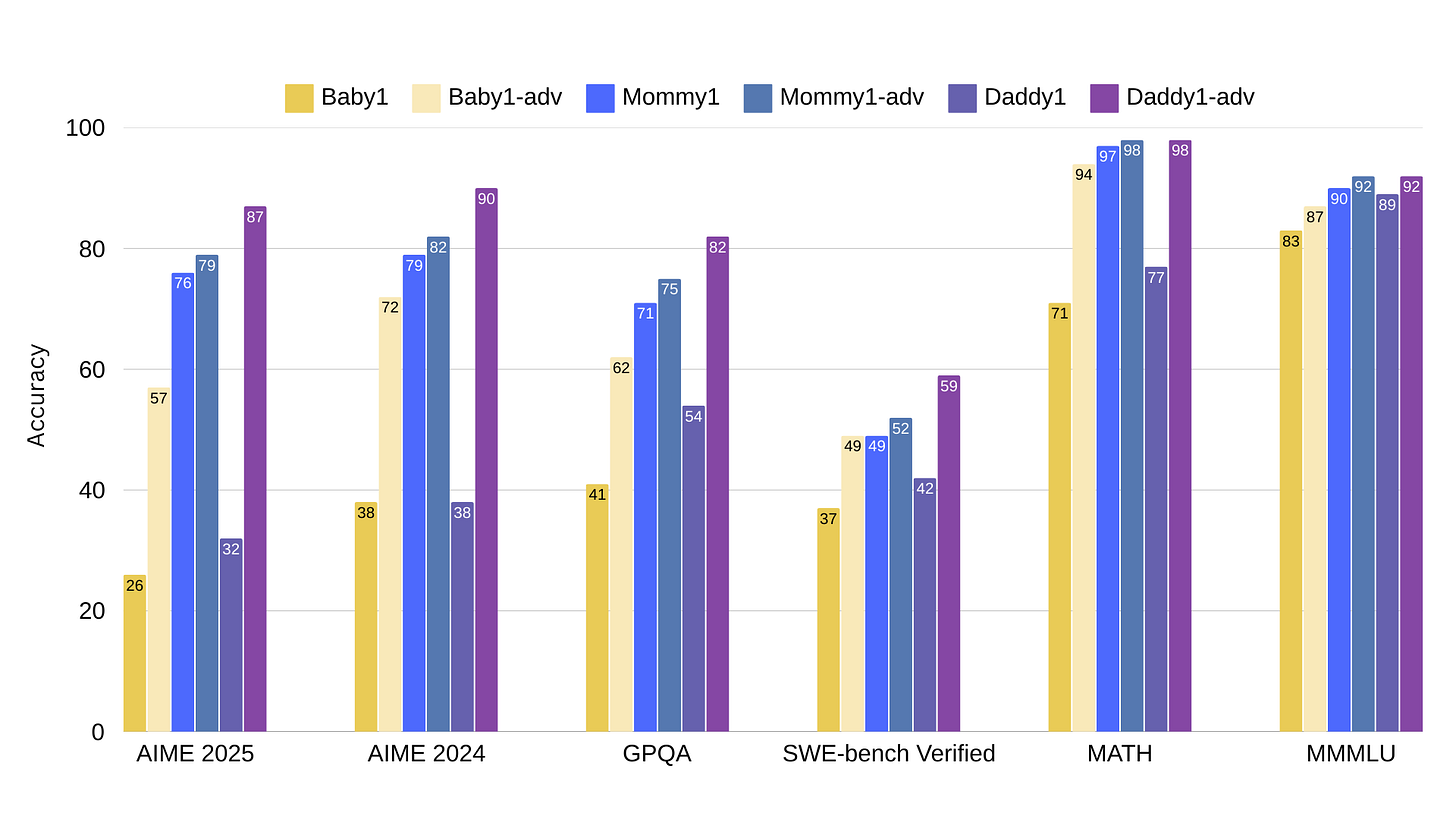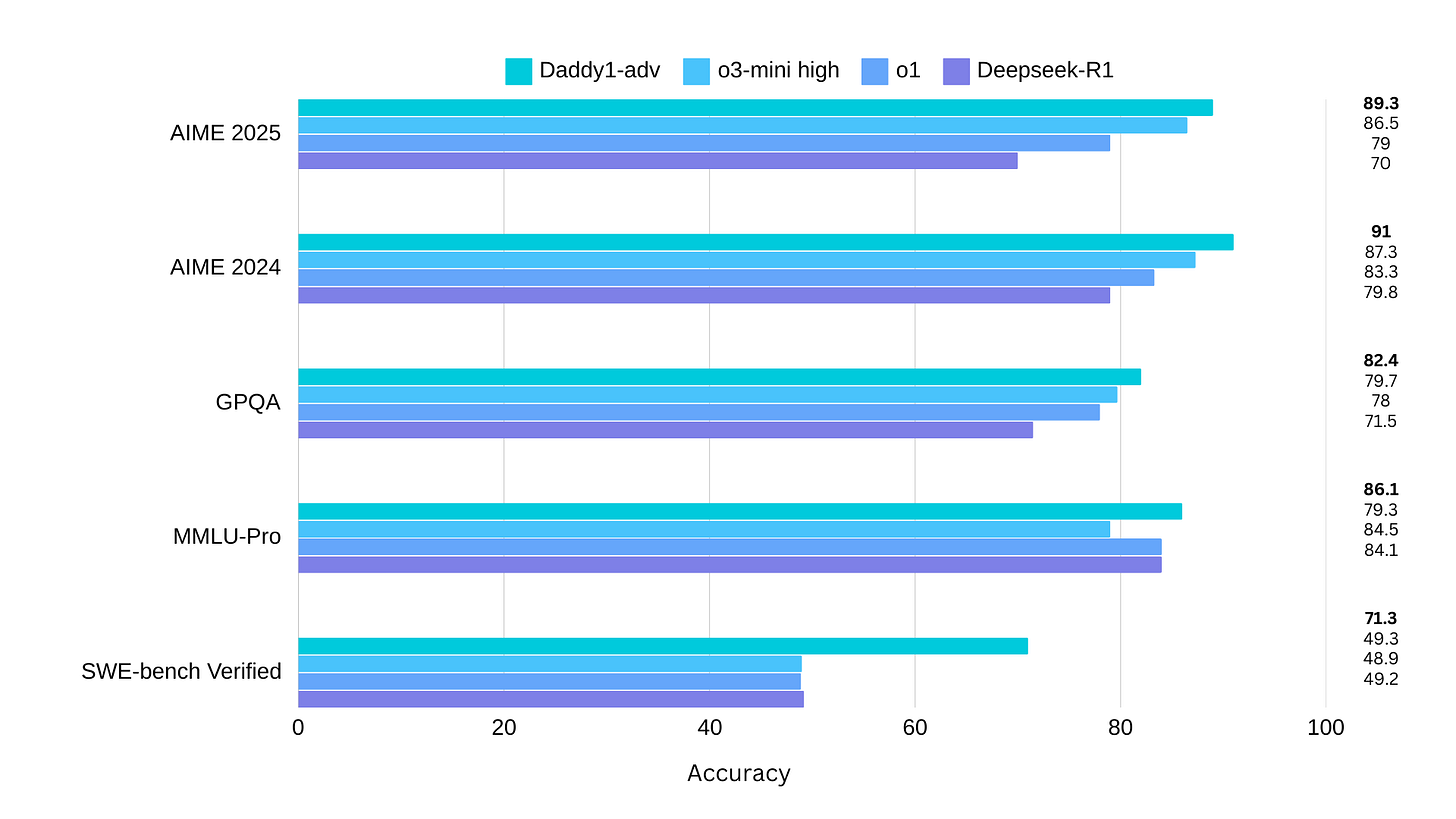Introducing HumChat & Brain Network
The most powerful way for making multiple models collaborate in a simple UX
After building with multiple GenAI models for 2+ years, from Mixtral-7B to the latest Claude Sonnet 3.7 and OpenAI o3-mini, we’ve identified all their wiknesses and learned how to overcome them.
SUMMARY
Unified Intelligence
HumChat: deep understanding user requests
Mix-models: more efficient & accurate AI models
Brain network: collaborative Mix-models
Benchmarks
Live coding: Claude 3.7 Sonnet vs Daddy1-adv
Unified intelligence is the new Gold standard
Anthropic just released Claude Sonnet 3.7, a hybrid AI reasoning model, combining rapid response capabilities with deeper reasoning abilities in a single system.
In GPT-5, OpenAI will integrate its "o-series" technology, creating a unified system capable of both quick responses and deep reasoning.
Though, all these providers keep their biasis and wiknesses:
- OpenAI tends to reproduce stereotypes, and shows drops in accuracy for lower English proficiency or lower education users.
o3-mini has demonstrated inconsistency in reasoning accuracy and coding generation capabilities.
- Claude Sonnet 3.7 sometimes misses crucial requirements and fails to comply with instructions. It overcomplicates solutions, especially for smaller, context-specific changes or writing tasks.
We found the hack to leverage the best skills of all each GenAI models: discover HumChat today.
Humiris AI Research team: Louis-Nicolas & Joël
HumChat: the 1rst AI that really understands your request
Humiris’ mission is to bring you the best answer.
Unbiased, accurate, reliable, enriched with web browsing and sources upon requested.
Training HumChat Brain to understand user requests was the 1rst step.
With Humiris AI Research team, we trained this brain using top-tier qualified user preference datasets and created more than 60,000 of our own model preference datasets, based on objective criterias such as quality, cost, speed & privacy.
Understanding user goal & intent is key for the AI to perform the right task and thinking.
Mix-models: more efficient & accurate AI models
Once HumChat Brain understands precisely the user intent, it has to decide which network to activate to answer the request.
The arms of HumChat Brain are Mix-models.
We’ve created Mix-models, using Humiris Mixture of AI, to combine state of the art GenAI models and leverage the strength of each model.
Ranging from Baby 1, Mommy 1 and the most powerful Daddy 1, Mix-models combine the latests models of OpenAI, Anthropic, DeepSeek, Google, Meta, Mistral, Cohere, Qwen.
Baby 1: fast, accurate, efficient & more versatile than GPT-4o mini
It’s the first of HumChat Mix-model range.
Designed for smaller tasks who need fast and efficient intelligence.
Baby 1 is a Mix-model composed of GPT-4o mini, Llama 3.3 60, Mixtral 8x22B and more.
Mommy 1: cutting edge Reasoning Mix-model
More powerful than Baby 1, Mommy 1 is capable of Reasoning like DeepSeek-R1 or OpenAI-o1.
Ideal for complex problem solving.
Daddy 1: ultra accurate, most powerful AI model
Imagine combining o3-mini, DeepSeek-R1 and Claude Sonnet 3.7.
This is Daddy 1.
The most accurate GenAI model on the market.
Normal Mode vs Brain Network
In Normal Mode, HumChat Brain identifies the best foundation model to answer the user request based on the context and goal of the user. The final output is produced by 1 model.
In Brain Network Mode, HumChat Brain activates multiple models inside the Mix-model, and distributes tasks to each model depending on their strengths.
Brain Network: introducing collaborative Mix-models
Instead of treating AI models as standalone systems, Brain Network introduces collaborative multi-model intelligence where AI models interact, work together on specific tasks to achieve the final goal of the user.
HumChat Brain Network interpretes the user’s final goal in different tasks and steps to be completed.
Then, based on the strengths of each foundation model, HumChat Brain Network atttributes tasks and prompts the different expert models.
Each model is aware of the large context, but focuses 1 very specific task, and thus produces more accurate results.
In the end, HumChat Brain aggregates the n-outputs, reformulate the final output and sends back to the user.
Open Brain
You can click on “Open Brain” to see the whole thinking and scrole through the answers of multiple foundation models used in the Brain Network.
Hide the Brain Network thinking by clicking “Close Brain”.
Search Mode
In HumChat, you can activate the Search in both Normal and Brain Network modes, to enable each model inside Mix-models to browse the web and enrich their answers.
You will find links to sources at the top of the final answer, or directly in the final answer.
More sources are available inside the thinking when clicking on “Open Brain”.
Benchmarks
We’ve had all Mix-models tested on MMLU, GPQA, Math-AIME, and SWE benchmarks.
Baby 1, Mommy 1 and Daddy 1 achieve higher results with Advanced / Brain Network mode activated.
The chart above provides a clear performance hierarchy, with Daddy1-adv emerging as the most powerful reasoning model.
Baby1 and Baby1-adv maintain efficiency while trading off raw accuracy, making them ideal for applications where speed and cost are prioritized over absolute precision.
Mommy1 and Mommy1-adv balance accuracy and efficiency, making them versatile for structured reasoning tasks.
Designed to push the boundaries of math, coding, and scientific analysis, Daddy1-adv delivers accurate, more precise, and deeply reasoned responses outperforming its predecessors in both accuracy and efficiency.
Through rigorous evaluations, Daddy1-adv has demonstrated:
- Superior logical reasoning compared to o3-mini high, o1, Deepseek-R1 and Claude 3.7 sonnet
- Clearer, more structured answers for complex real-world challenges and better human request understanding.
With advanced reasoning capabilities, Daddy1-adv outperforms standard models on key benchmarks such as AIME, GPQA, and SWE-bench Verified, making it the leading AI choice for technical fields requiring deep analytical power.
For users who need the best in AI-driven reasoning, problem-solving, and efficiency, Daddy1-adv stands as the ultimate choice.
Use case: live-coding Mario's Snake game
We’ve run a Coding competition between Daddy1-adv (with Brain Network) and Claude 3.7 Sonnet.
Here was the prompt: “Create a snake game with mario car. Use Python.”
After running both Daddy1-adv and Claude 3.7 Sonnet, it appears that Claude did not produce a playable game that respects classic Snake game rule.
Daddy1-adv proposed a understandable, enjoyable game as you can see above. The Mix-model had indeed a better understanding of “mario car”, including colorful and fixed obstacles. It produced a better game on a human experience level.
HumChat Mix-model Daddy1-adv proved better skills in logic, maths & coding combined than Claude 3.7 Sonnet. We’ve been able to generate a functionnal full video game in 1 request.
Conclusion
The future of AI is unified intelligence: a dynamic collaboration between models that understand context, optimize efficiency, and enhance reasoning.
The Mix-models available in HumChat, are redifining the standard of Human-AI interaction with intent-driven understanding, and collaborative reasoning.
We have cracked the code: instead of relying on one model's strengths and weaknesses, we let AI models work together. HumChat’s Brain Network distributes tasks strategically, ensuring unmatched accuracy, cost-efficiency, and performance.
With Daddy1-adv outperforming top-tier models in coding, reasoning, and problem-solving, the message is clear: the single-model era is over.
🚀 Ready to experience the future of AI?
Looking forward to your feedback!
You’re welcome to join our open AI Builder community :)
https://discord.com/invite/2xZVUpU4xf





